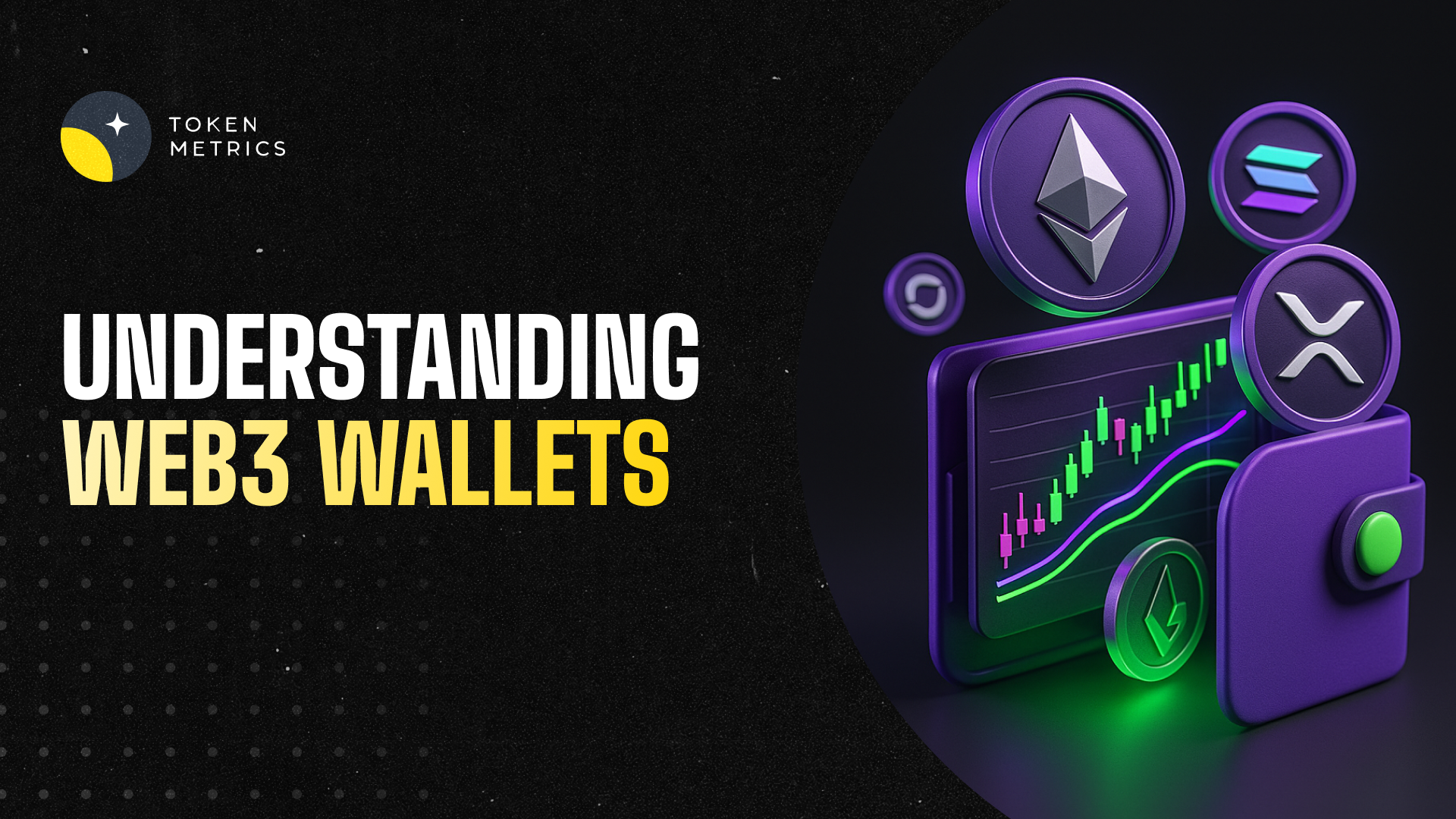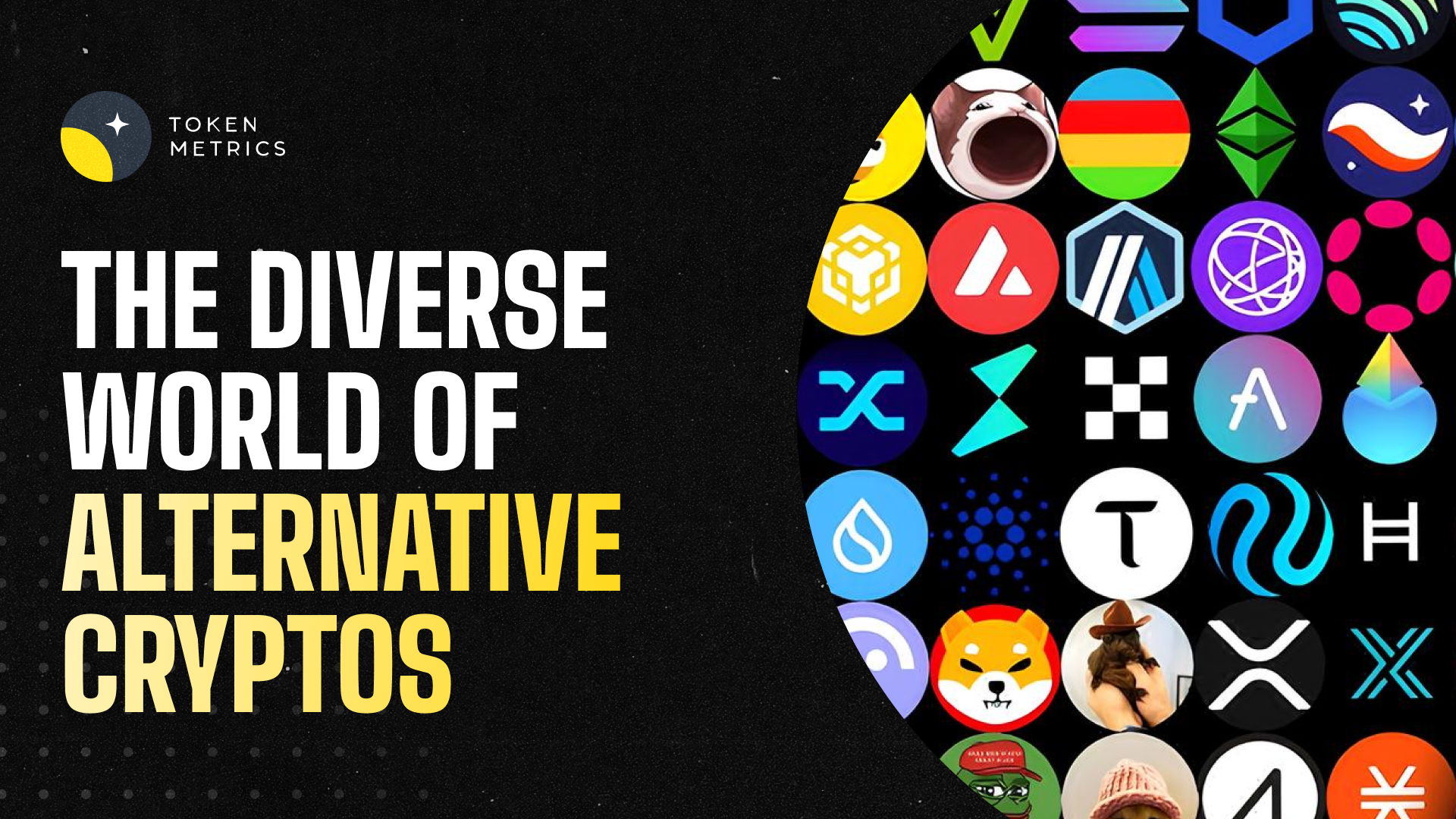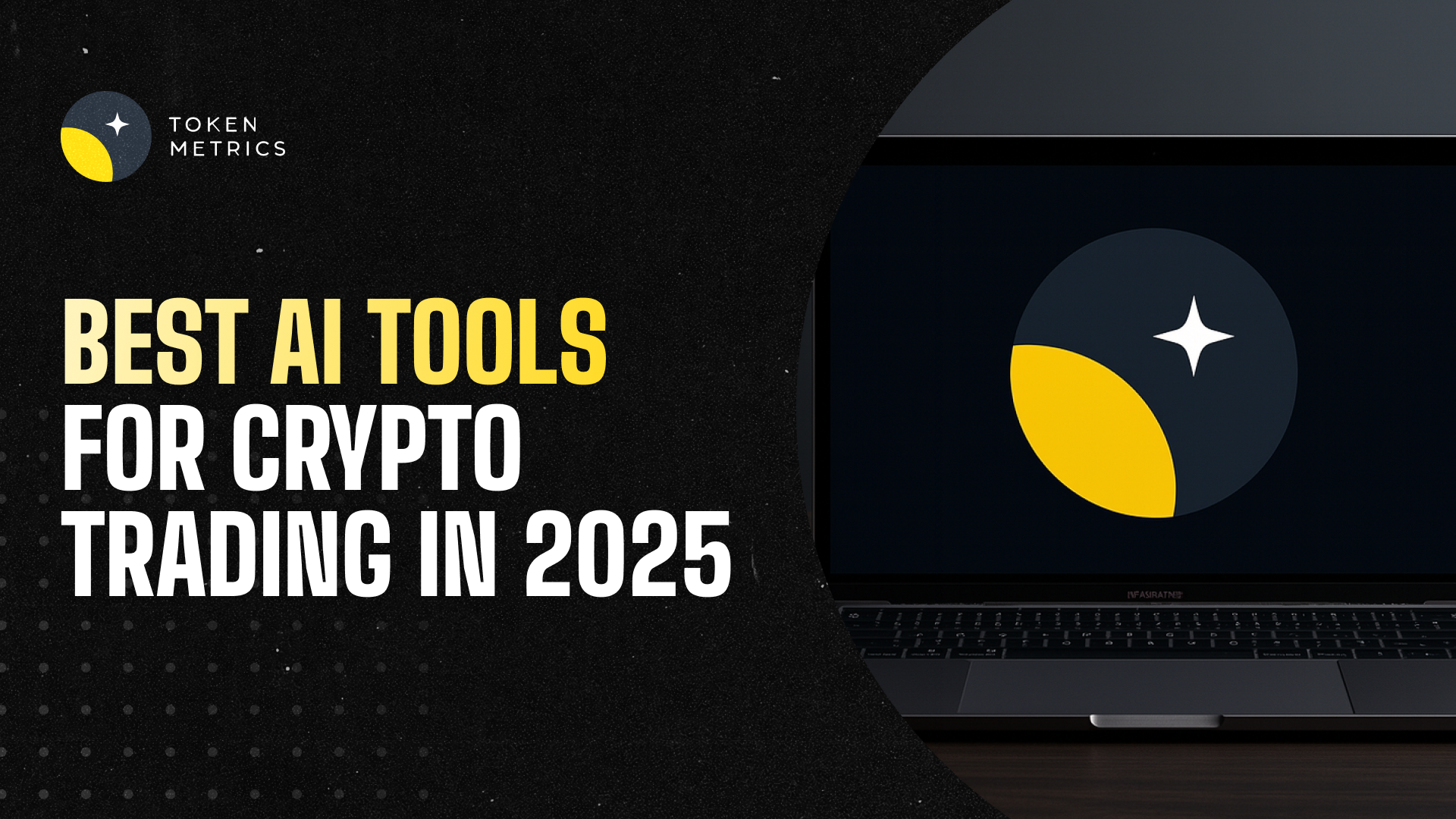How to Buy Ethereum (ETH) Easily on Token Metrics
%201.svg)
%201.svg)
.png)
Why Buy Ethereum?
Ethereum (ETH) is more than just a cryptocurrency—it's the backbone of decentralized finance (DeFi), NFTs, and smart contract applications. As the second-largest crypto by market cap, Ethereum continues to be a top investment choice for those looking to participate in the future of blockchain technology.
Now, buying ETH has never been easier! With Token Metrics, you can research, analyze, and purchase Ethereum all in one seamless experience.
Step-by-Step Guide: How to Buy Ethereum
1. Get Started on Token Metrics
To purchase ETH, you first need to access the Token Metrics trading platform. Simply log in to your Token Metrics account and navigate to the trading section.
2. Fund Your Web3 Wallet
Before making a purchase, ensure that you have a Web3 wallet such as MetaMask or Trust Wallet. Fund your wallet with crypto or stablecoins to facilitate transactions smoothly.
3. Use AI-Powered Analysis for Smarter Investing
Before buying, leverage Token Metrics' AI trading assistant (TMAI) to get real-time technical analysis and price predictions for Ethereum. Our AI-driven insights help you make informed decisions based on market trends and signals.
4. Buy Ethereum Seamlessly
Once you've reviewed Ethereum's performance, you can execute your trade directly on Token Metrics—no need to switch between multiple apps or exchanges. Simply enter the amount of ETH you want to purchase and confirm your transaction.
5. Securely Store Your ETH
After purchasing Ethereum, you can store it in your Web3 wallet for easy access or transfer it to a hardware wallet for added security.
Why Buy Ethereum on Token Metrics?
- One-Stop Platform: Research, analyze, and invest—all in one place.
- AI-Powered Insights: Get expert-level market analysis before purchasing.
- Secure & Easy Transactions: No need for multiple apps or exchanges—buy ETH directly on Token Metrics.
- Web3 Integration: Trade ETH effortlessly with your Web3 wallet.
Invest in Ethereum Today with Token Metrics!
Ethereum is at the forefront of blockchain innovation, and now you can buy ETH effortlessly on Token Metrics. Get started today and stay ahead in the crypto revolution!
AI Agents in Minutes, Not Months


Create Your Free Token Metrics Account





.png)
Recent Posts

Understanding Web3 Wallets: Your Guide to Secure Crypto Asset Management
%201.svg)
%201.svg)
Introduction to Web3 Wallets
As the blockchain landscape evolves, the term "Web3 wallets" has become fundamental in discussions around decentralized finance and digital asset management. Web3 wallets act as a gateway for users to interact with decentralized applications (dApps), access blockchain networks, and securely manage their digital assets without reliance on centralized intermediaries.
This article explores the concept of Web3 wallets, their types, core features, and the security considerations essential for users. It also highlights how analytical platforms like Token Metrics can aid in understanding the complexities surrounding these wallets and blockchain technologies.
What Are Web3 Wallets?
Web3 wallets are software or hardware tools that enable users to store, send, receive, and interact with cryptocurrencies and tokens on blockchain networks. Unlike traditional digital wallets, Web3 wallets are designed primarily to facilitate decentralized interactions beyond simple transactions, such as signing smart contracts and accessing dApps.
They come in two main forms:
- Custodial wallets: Where a third party holds the private keys on behalf of the user. This category offers convenience but introduces counterparty risk.
- Non-custodial wallets: Users retain full control of their private keys. This type aligns with the ethos of decentralization, offering enhanced security but requiring users to take responsibility for key management.
Types of Web3 Wallets
Understanding the various types of Web3 wallets helps users select options that fit their security posture and use cases.
- Software Wallets: Installed as browser extensions or mobile apps, these wallets offer easy access and integration with dApps. Examples include MetaMask and Trust Wallet.
- Hardware Wallets: Physical devices that store private keys offline, significantly reducing exposure to hacks. Examples include Ledger and Trezor.
- Smart Contract Wallets: Wallets deployed as smart contracts allow for programmable control over funds, including multi-signature functionality and customizable security policies.
Key Features and Functionalities
Web3 wallets provide a suite of functionalities tailored to decentralized ecosystems:
- Private Key Management: Safe handling and storage of private keys, either locally or hardware-backed, is central to wallet security.
- Transaction Signing: Wallets enable users to approve blockchain transactions through cryptographic signatures.
- dApp Integration: Seamless interaction with Web3 applications via standardized protocols like WalletConnect.
- Multi-Chain Support: Ability to interact with different blockchain networks within a single interface.
- Token Management: Displaying and organizing various tokens compliant with standards such as ERC-20 or BEP-20.
Security Considerations for Web3 Wallets
Security remains paramount for Web3 wallet users due to the irreversible nature of blockchain transactions and increasing cyber threats:
- Private Key Confidentiality: Exposure of private keys or seed phrases can result in total asset loss. Users should store these securely offline.
- Phishing Attacks: Malicious actors may use fake websites or apps to steal credentials; exercising caution and verifying authenticity is critical.
- Software Vulnerabilities: Keeping wallet software updated and using reputable wallets can minimize risks related to bugs or exploits.
- Hardware Storage: Hardware wallets mitigate online threats by keeping keys offline but require physical safeguarding.
Leveraging AI Tools for In-Depth Analysis
The complexity of blockchain ecosystems has led to the emergence of AI-driven analytical platforms that assist users and researchers in understanding market trends, token metrics, and network behaviors. Token Metrics is an example of such a tool, providing data-backed ratings and insights that can complement wallet usage by offering research capabilities on tokens and market conditions.
These platforms can support educational efforts by:
- Providing fundamentals and trend analysis based on on-chain and market data.
- Offering scenario analysis to understand potential developments in blockchain protocols.
- Enhancing security posture by informing users about project credibility and token performance metrics.
Practical Steps to Choose and Use Web3 Wallets
Choosing the right Web3 wallet is a process that balances ease of use, security, and compatibility needs:
- Research Wallet Types: Understand differences between custodial and non-custodial options.
- Assess Security Features: Review if the wallet supports hardware integration, multi-factor authentication, or multisig capabilities.
- Confirm dApp Compatibility: If interaction with decentralized platforms is important, ensure smooth integration.
- Backup Procedures: Follow recommended practices for seed phrase storage and wallet backup.
Additionally, engaging with AI-driven platforms like Token Metrics can provide analytical depth during the research phase and support ongoing management of crypto assets.
Conclusion and Disclaimer
Web3 wallets represent a critical component of the decentralized internet, empowering users to control their digital assets and participate in blockchain ecosystems securely and effectively. By understanding wallet types, functionalities, and security measures, users can navigate this complex space with greater confidence.
Tools like Token Metrics serve as valuable resources for educational and analytical purposes, enabling deeper insight into token fundamentals and network dynamics.
Disclaimer: This article is intended for educational purposes only and does not constitute financial or investment advice. Readers should conduct their own research and consider their risk tolerance before engaging with any cryptocurrency or blockchain technology.

Understanding Altcoins: The Diverse World of Alternative Cryptocurrencies
%201.svg)
%201.svg)
Introduction to Altcoins
The term altcoins broadly refers to all cryptocurrencies that exist as alternatives to Bitcoin, the pioneering digital currency. Since Bitcoin’s inception in 2009, thousands of alternative crypto coins have emerged with a variety of designs, purposes, and technologies. Understanding what altcoins are and how they differ from Bitcoin and one another is vital for anyone interested in the cryptocurrency ecosystem.
Definition and Types of Altcoins
Altcoins are digital assets that operate on blockchain technology but distinguish themselves from Bitcoin in technical structure or intended utility. Technically, the name is a contraction of “alternative coins.” Altcoins encompass a wide range of projects, including but not limited to:
Technological Innovations in Altcoins
Many altcoins distinguish themselves by innovating on blockchain design, consensus mechanisms, scalability, and privacy. For instance, some use Proof of Stake instead of Bitcoin’s Proof of Work to reduce energy consumption. Others implement advanced cryptographic techniques to enhance transaction confidentiality. These technical differences contribute to the diverse use cases altcoins pursue and can affect their adoption and network effects within various communities.
Evaluating Altcoins and Research Approaches
Evaluating altcoins requires a multifaceted approach that considers technology fundamentals, development activity, community support, and use cases. Research techniques often include:
Advanced AI-driven research tools like Token Metrics synthesize vast amounts of data and market signals to provide quantitative ratings and analysis, aiding in a more informed understanding of altcoin projects.
Altcoins vs Bitcoin: Key Differences
While Bitcoin is primarily conceived as a decentralized digital currency and store of value, altcoins often aim to address specific limitations or explore novel functionalities. Differences can include:
Understanding these distinctions informs discussions around the complementary roles altcoins play alongside Bitcoin in the broader crypto ecosystem.
Considering Risks and Complexities
Due to the large number and variety of altcoins, the space involves considerable complexity and risk. Important considerations include:
Using analytics platforms like Token Metrics can provide data-driven insights into these factors by compiling technical, fundamental, and sentiment indicators.
Practical Steps for Using AI Tools in Altcoin Analysis
AI-powered platforms enable systematic, scalable analysis of altcoins through machine learning models harnessing blockchain data, news sentiment, and market indicators. To incorporate these tools effectively:
Conclusion and Key Takeaways
Altcoins represent a diverse and rapidly evolving segment of the cryptocurrency landscape, designed to explore new functionalities and solve various challenges beyond Bitcoin’s scope. They encompass broad categories, from payments and smart contract platforms to privacy and stablecoins. Due to the complexity and number of projects, rigorous, data-informed research approaches are essential to understand their technology, use cases, and network health.
AI-driven research tools such as Token Metrics offer valuable support in this endeavor by aggregating multiple data streams into comprehensive analysis, helping stakeholders objectively compare altcoins on various factors.
Disclaimer
This blog post is for educational and informational purposes only and does not constitute financial, investment, or trading advice. Readers should conduct their own independent research before engaging with cryptocurrencies.

Best AI Tools for Crypto Trading in 2025: Smarter Strategies for Maximum Profits
%201.svg)
%201.svg)
Introduction: Why AI Is Transforming Crypto Trading
In 2025, cryptocurrency trading has evolved far beyond manual chart analysis and intuition. Artificial Intelligence (AI) is now at the forefront of trading strategies, enabling investors to process massive amounts of data, predict market movements, and make faster, smarter decisions.
AI trading tools have become indispensable for retail and institutional traders alike, offering insights that were once only available to hedge funds with large research teams. This article explores the best AI tools for crypto trading in 2025, with a special focus on how platforms like Token Metrics give traders a competitive edge.
What Are AI Crypto Trading Tools?
AI crypto trading tools use machine learning algorithms, predictive analytics, and natural language processing to analyze market data and provide actionable insights.
These platforms help traders:
- Predict Price Movements: Using historical data and sentiment analysis.
- Detect Emerging Trends: Spotting narratives like AI coins, DeFi, and Layer 2 growth early.
- Automate Trades: Executing strategies faster than manual trading.
- Manage Risk: Offering portfolio rebalancing and stop‑loss recommendations.
In short, AI tools turn complex crypto data into clear, actionable decisions.
1. Token Metrics — The All‑In‑One AI Trading Platform

Best For: Portfolio optimization, coin ratings, and narrative detection
Token Metrics is one of the most advanced AI‑powered crypto platforms in 2025. Designed for both traders and long‑term investors, it uses over 80 data points per token to generate AI‑driven ratings, predictions, and portfolio recommendations.
Key Features:
- AI Coin Ratings: Score cryptocurrencies based on fundamentals, technicals, sentiment, and on‑chain data.
- Narrative Detection: Identify early‑stage trends like AI tokens or real‑world asset tokenization before they go mainstream.
- Portfolio Optimization: Create a personalized, data‑driven portfolio aligned with your goals and risk tolerance.
- Trading Signals & Alerts: Get real‑time updates on bullish/bearish movements.
Why It’s Great:
Token Metrics is more than a tool — it’s a full trading intelligence platform. It helps users discover hidden gems, fine‑tune strategies, and stay ahead of shifting market conditions.
2. CryptoHopper — AI‑Driven Trading Automation

Best For: Automated crypto trading bots
CryptoHopper allows traders to automate their trading strategies using AI‑powered bots. It connects to major exchanges and executes trades based on predefined conditions, reducing emotional trading.
Key Features:
- AI‑Driven Bots: Adapt strategies based on real‑time data.
- Backtesting: Test strategies against historical market performance.
- Social Trading: Copy strategies from experienced traders.
Why It’s Great:
For traders who want hands‑off execution, CryptoHopper provides robust automation paired with AI insights.
3. 3Commas — AI for Portfolio and Trade Management

Best For: Multi‑exchange trading and smart portfolio management
3Commas combines AI‑driven analytics with smart trading tools, allowing users to execute trades across multiple exchanges.
Key Features:
- AI Portfolio Management: Optimize holdings using automated rebalancing.
- Trading Bots: Configure AI bots for spot, futures, or options markets.
- SmartTrade Terminal: Advanced order types for precision trading.
Why It’s Great:
3Commas is ideal for active traders managing multiple accounts across different platforms.
4. Pionex — AI‑Powered Grid Trading

Best For: Grid and arbitrage trading
Pionex specializes in AI‑powered grid trading, which profits from market volatility.
Key Features:
- AI Grid Bots: Automate buy‑low, sell‑high strategies.
- Arbitrage Bots: Capitalize on price differences across exchanges.
- Low Fees: Competitive rates for active traders.
Why It’s Great:
Pionex helps beginner and intermediate traders profit from sideways markets using low‑maintenance AI bots.
5. Numerai Signals — AI for Predictive Trading
Best For: Crowdsourced AI predictions
Numerai Signals collects machine learning models from data scientists worldwide to generate highly predictive trading insights.
Key Features:
- Crowdsourced AI Models: Benefit from collective intelligence.
- Predictive Signals: Forecast market moves using advanced algorithms.
- Quantitative Trading: Build data‑driven strategies with institutional‑grade tools.
Why It’s Great:
Numerai offers unique crowdsourced intelligence, making it an attractive tool for data‑driven traders.
How to Choose the Right AI Trading Tool
When selecting a platform, consider:
- Your Goals: Are you looking for portfolio optimization, day trading, or automation?
- Ease of Use: Some tools require technical expertise, while others (like Token Metrics) are beginner‑friendly.
- Data Sources: Ensure the tool uses reliable, real‑time market data.
- Integration: Check if it works with your preferred exchanges or wallets.
Combining AI Tools for Maximum Impact
The best approach in 2025 isn’t using just one tool — it’s combining multiple platforms:
- Use Token Metrics for narrative detection and portfolio building.
- Automate execution with CryptoHopper or 3Commas.
- Apply Pionex bots for volatility trading and arbitrage opportunities.
This hybrid approach creates a comprehensive AI‑driven trading strategy.
Risks of AI Trading Tools
While AI can enhance trading, it isn’t foolproof:
- Overreliance on Bots: AI models can fail during extreme volatility.
- Data Quality Issues: Poor‑quality data leads to inaccurate predictions.
- Security Risks: Using third‑party tools requires strong cybersecurity practices.
Using Token Metrics’ AI analytics helps mitigate these risks by providing transparent, multi‑factor coin ratings.
Conclusion
AI is transforming how crypto trading works in 2025. From narrative detection to automated execution, these tools give traders the ability to make smarter, faster, and more profitable decisions.
Token Metrics leads the way, offering AI‑powered coin ratings, trend detection, and portfolio optimization — making it the ideal platform for traders and investors aiming to stay ahead in a volatile market.
In crypto, information is power — and with the right AI tools, you can turn that information into consistent profits.


Get Your Brand in Front of 150,000+ Crypto Investors!




 Create Your Free Account
Create Your Free Account9450 SW Gemini Dr
PMB 59348
Beaverton, Oregon 97008-7105 US
.svg)
No Credit Card Required


Online Payment


SSL Encrypted
.png)
Products
Subscribe to Newsletter
Token Metrics Media LLC is a regular publication of information, analysis, and commentary focused especially on blockchain technology and business, cryptocurrency, blockchain-based tokens, market trends, and trading strategies.
Token Metrics Media LLC does not provide individually tailored investment advice and does not take a subscriber’s or anyone’s personal circumstances into consideration when discussing investments; nor is Token Metrics Advisers LLC registered as an investment adviser or broker-dealer in any jurisdiction.
Information contained herein is not an offer or solicitation to buy, hold, or sell any security. The Token Metrics team has advised and invested in many blockchain companies. A complete list of their advisory roles and current holdings can be viewed here: https://tokenmetrics.com/disclosures.html/
Token Metrics Media LLC relies on information from various sources believed to be reliable, including clients and third parties, but cannot guarantee the accuracy and completeness of that information. Additionally, Token Metrics Media LLC does not provide tax advice, and investors are encouraged to consult with their personal tax advisors.
All investing involves risk, including the possible loss of money you invest, and past performance does not guarantee future performance. Ratings and price predictions are provided for informational and illustrative purposes, and may not reflect actual future performance.




%201.svg)

